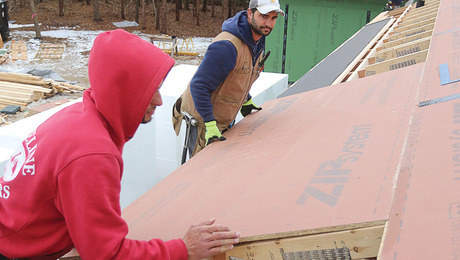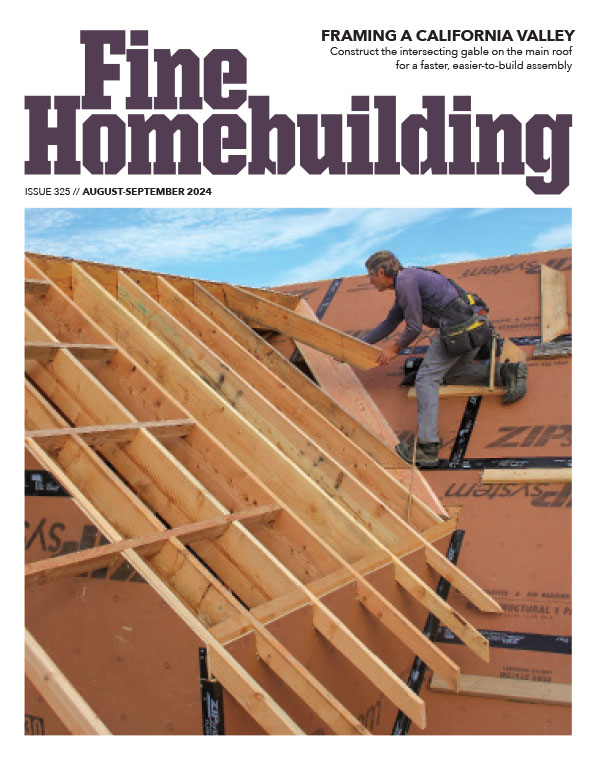I have got four cracks in the edge joints of my dw ceiling in my shop. Just happend over night. Cracks run across the shop (30’x42′), and are just about centered in the 42′ length.
Ceiling is 5/8 dw on 2×4 straps beneath trusses 4″o.c.. No insulation yet and no heat in the building yet. No butt jount have cracked. The dw is glued and screwed, and I used fiber mesh tape (the tape was free). We have had some really mild weather, although wet. No roof leaks, nor have I noticed any condensation on the inside of the metal roof. The building has been dried in for two years and the dw was hung and finished about this time last year, but not painted.
I know what I have to do to fix it, that is not the question. What caused it? I’ll retape with paper tape, but unless I solve this movement problem, it will propably also crack. Will the attic insulation help?
Give me some theories or guess as to what is going on.
Dave















Replies
If your sheets run length wise and the cracks are on the factory edge, truss movement may be to blame. If the various truss members go through climatic changes it will pull up on the bottom cord when things get damp and dry out. You may notice the center of the ceiling crowning up. In houses we see the ceiling pull up leaving a crack at the top of center walls if the following is not done. The ceiling should have a vapor barrier on the interior surface under the insulation. You didn't mention if you installed a vapor barrier so the best bet may be to use craft faced insulation for the first layer. You probably won't generate that much moisture in the shop unless you run big steam boxes. I would not lay poly over the bottom cords. Heating and cooling will be less expensive if insulated R-38 or higher. The roof should have continuous vents at the soffits and a ridgevent. If you leave out one of these components the system won't work properly. Use "propa" vents to prevent insulation from blocking the soffit air flow. Gable louvers won't do the trick.
My first thought is frming movement related to recent weather changes.
Excellence is its own reward!
I have a full ridge vent and soffit vents. The stapping runs perpendicular to the bottom cord of the trusses at 2' oc. No vapor barrier based on concensus of opinion on this forum, b/c of the no moisture generated in a woodworking/remodelers shop.
The edge joints of the drywall fall about 6" from breaking on where the strapping crosses the bottom cord of each truss. Right now the first crach appears 16' fro the end wall and each sheet of dw has one for the next three sheets.
Blown cellulose is to be installed to 12" thick for an R-38 next week end.
My first thought was truss uplift also. I have seen this happen in trussed roofs, but the cracks always appeared at the wall to ceiling corners. I have never seen edge cracking out in the middle of a room.
What makes this curiouse is that the dw was hung and finished last year. It went through all of last winter, and a very wet (so far) year, this year without any cracks. If the weather went from wet to extremely dry, I would suspect uplift. The same thing if there had been a sudden cold snap that would lower the RH and cause rapid drying. None of that has happened. It is still wet and mild here.
I was in the shop yesterday, making room for some new toys I am picking up tomorrow---- no cracks. Went back this morning to paint the ceilings and walls in the cleared are and presto----#*$ cracks in my ceiling.
I am thinking of pulling a jet line down the center of the shop, about 6" below the ceiling, and taking precise measurements at each truss location for a few days. That should tell me if they are moving very much, either up or down.
Dave
Sounds like your shop is built like a tank! If I'm reading you correctly you may have run the sheetrock the wrong way, length ways with the building. We always run perpedicular to the strapping with the butt joints landing on a strapping and the factory edge unsupported from strapping to strapping, normally 1x3 or 1x4 at 16" OC. Truss should be laterally braced continuously, we run x braces on the longest cord running one x on the back and one on the front. Bracing goes on both the front and back of building. Essentially a double row of x braces from peak to bottom and back to peak. This is generally stated in the truss design sheet and in most codes. This adds a great deal of rigidity to the overall structure. Usually when I see truss lift it is along the center wall and it can really open up, 1/2" or more. The lift is due to high humidity in the chord members, somehow the way they related to each other pulls up the bottom cord. Particularly with W style truss. Hairline cracks that come and go must be due to slight climactic changes. Might be interesting to put a thermometer up there and also take some moisture meter readings on the truss cords. I figure anyone with a sheetrocked ceiling in the shop must have a meter. I'm jealous. And it's taped and painted too!
It is built as you describe, truss bracing included. Straps are perpendicular to the trusses, and dw is perpendicular to the strapping.
I think everyone is correct about it being truss uplift. That is pretty much a given, and the edge cracking may be because of the joint location in relationship to the truss spacing. As the truss members dry and lift the stapping is moving up with them, but b/c of the 4' oc spacing it is more uneven than in a standard 2' oc spacing. You don't normally see cracking in the center on a strapped ceiling because everything is moving up as a single membrain, with the lift occurring every two feet. Here the lift is every four feet, and the edge joints are slightly offsett (6") from the moving bottom cords.
My other concern was the mesh tape. I have never used this much of it. Someone gave me six rolls of it, so I thought I would try it on the shop. It did not impress me, even though it was faster than hand tapping with paper tape. I am going to strip it out of the cracked joints, and go back with paper tape.
I don't have a moisture meter, but maybe Santa will bring me one. :-) I am picking up a 15" thickness planner and 23' drum sander today,so the moisture meter was already on my get next list. I have about 1500 bf of hardwood sticker and drying already. Another 3000 bf is still in the logs, but should be sawed before spring. Yep the moisture meter is a must.
Dave
You need to use durabond 90 with mesh tape. Did you stagger your butts?
I think Mike has your ultimate answer here. The problem isn't the mesh tape per se, but using ordinary drying-type mud to set the tape. You need plaster-based, setting-type compound -- Durabond or equivalent -- to tape w/ mesh. (EZ Sand is not an equivalent for this purpose.) Durabond is amazing stuff. I've never seen it crack in any of many varied patch situations done over a number of years. Only use it to tape, of course; finish w/ regular mud. You can use paper tape, but mesh tape makes an easier-covering joint.
hey hammer. are you a r2000 builder. your right the building needs a vapor barrier
I don't know what an r2000 builder is. How about some info. Thanks.
r2000 is the type of homes my company builds. its a house that is built airtight. this keeps the moisture out and fresh air in. this keeps the power bill down.
VP keeps the moisture out?
Vp should keep the moisture inside the building in cold climates, and thus out of the wall/ceiling assembly. In hot humid climates with central a/c usage the vp needs to be outside to prevent moisture condensation on the cool inside membrain of the wall/ceiling assembly.
My shop has tyvek outside over 1/2" sheating and 1/2" Tuff R rigid foam. Everything outside was tape, foamed, caulked and sealed tight as a mouses ear. Inside, there iare no uncotrolled moisture generating sources. Consensus at tghis site was an internal vp was overkill.
Would you mind explaining how a vp would have stopped the truss uplift and dw cracking problem.
Dave
two things, one would be truss lift. The other would be moisture change. If you recently fired up a furnance the dryall RMC could have dried up causing the crack or the changes in temp could have caused the trusses to move.
what kind of roof venting do you have? Any interior partions that the trusses might have been mistakingly fastened to? Any major weather changes to your area? Those all might be playing factors into your crack.
No expert but I have seen a situation where the ceiling cracking was only solved, after several retapings and refinishing, by adding a couple of expansion joints to allow the materials to move in a location of their choosing and an acceptable manner.